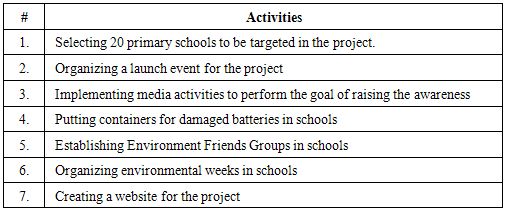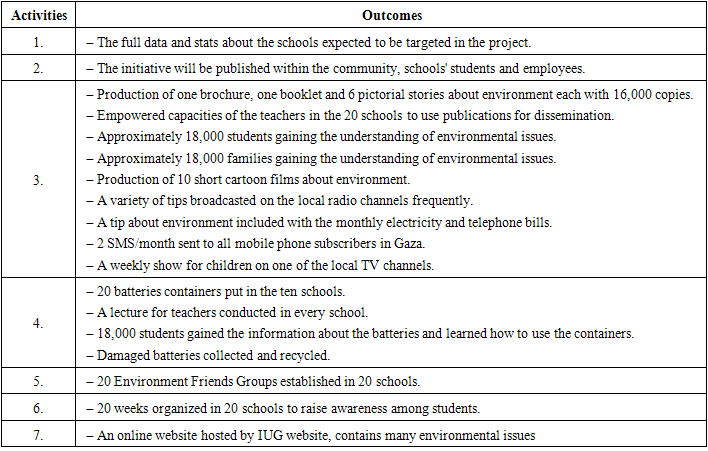-
Paper Information
- Paper Submission
-
Journal Information
- About This Journal
- Editorial Board
- Current Issue
- Archive
- Author Guidelines
- Contact Us
American Journal of Environmental Engineering
p-ISSN: 2166-4633 e-ISSN: 2166-465X
2015; 5(1): 32-37
doi:10.5923/j.ajee.20150501.03
Increase Community Awareness about the Environment, Renewable Energy and the Concept of Sustainability in Gaza Strip
Anwar Abu-Zarifa
Industrial Engineering department, Faculty of Engineering, Islamic University of Gaza, Gaza, State of Palestine
Correspondence to: Anwar Abu-Zarifa, Industrial Engineering department, Faculty of Engineering, Islamic University of Gaza, Gaza, State of Palestine.
| Email: |  |
Copyright © 2015 Scientific & Academic Publishing. All Rights Reserved.
The environment situation in Gaza Strip is very serious due to many reasons such as underinvestment in environmental systems, lack of progress on priority environmental projects and the recent escalation of hostilities. After the last war, children of Gaza suffer the most, as the economic family needs have to take priority over a child’s right. Children are the most receptive and have a great capacity for learning, so they are targeted by this project in order to raise and disseminate environmental awareness.This paper presents methodic and strategies to raising the environmental sense and increasing the public awareness of using renewable energies in Gaza Strip. Raising the environmental sense is an important and pivotal issue either now or in the future. In response to this issue, this paper aims to build capacity on environmental awareness to the community through children as many of our young children play a very important role within a family framework at a time in their development – they represent the future for all of us. Targeting children in this project is a very effective way of disseminating important message within the community – children bring their knowledge home and share it with their families and communities.
Keywords: Renewable Energy, Public Awareness, Palestine, Gaza Strip
Cite this paper: Anwar Abu-Zarifa, Increase Community Awareness about the Environment, Renewable Energy and the Concept of Sustainability in Gaza Strip, American Journal of Environmental Engineering, Vol. 5 No. 1, 2015, pp. 32-37. doi: 10.5923/j.ajee.20150501.03.
Article Outline
1. Introduction
- Gaza Strip has been a theatre of conflict for decades. Each of these conflicts has left its mark, and over time, a significant environmental footprint has developed in Gaza Strip. During the most recent fighting, between 2008 and 2014, Israeli Defense Forces conducted a major combined military operation in Gaza Strip. Military operations included bombing of land from the sea and air strikes. The mindset of most people there focused on safe life and the needs of everyday life, see Fig 1.Notwithstanding a general unfamiliarity with environmental issues, there is a perceptible increase of environmental consciousness among Palestinians. The environmental education initiative has been taken by grassroots organizations and NGO’s, but this must expand to be shared at all levels, from the policy makers to the grassroots. Publications, media programming, regular columns, educational curriculums and the formation of formal institutions such as a Palestinian Nature Protection Society may be forums for expanding awareness. An “environmental ethic” must be cultivated and adopted, in which resources – clean air, land and water – are viewed as precious assets to be carefully protected, managed and allocated. Environmental education should have priority status in the quest for sustainable development. In Addition, sufficient financial resources should be allocated to transform this into reality [1].By the 1980s, a critique of eco-Marxism was in the offing, given empirical data from countries that were attempting to wed environmental protection with economic growth instead of seeing them as separate. Popular examples of ecological modernization would be "cradle to cradle" production cycles, industrial ecology, large-scale organic agriculture, biomimicry, permaculture, agroecology and certain strands of sustainable development—all implying that economic growth is possible if that growth is well organized with the environment in mind [2]. The many volumes of the German sociologist Ulrich Beck first argued from the late 1980s that the environmental social movements of the world into structural change are potentially transforming the risk society without rejecting the benefits of modernization and industrialization [3]. An example of the confusion policy regarding the environment can may be clearly seen once, when Palestinian political support for international collaboration for building a port in Gaza is considered detrimental to coastal preservation efforts [4]. Technological progress in the industrialized countries and thus depending subjective perception of themselves and the environment should be promoted more. The environmental hazards and the interference of politics, whether by Israelis or Palestinian part, reflected in the attitude of the people of Gaza concerning the importance of environmental protection. The perception of environment and sustainability and is therefore, in the population in Gaza not complete and clear.Concerning the energy consumption and energy supply in Gaza Strip should be mentioned, that Gaza Strip electricity demand ranges between 240 and 280 megawatts (MW). The power supply comes from three sources, Israel, Egypt and generated by its own Gaza power plant, whose actual manufacturing capacity is limited to 60-70 MW because of shortages of spare parts and necessary fuel. There is a permanent deficit in nearly 40% of the required electricity. Figure 2 shows the electricity supplies in Gaza strip 2004- 2012, trend increasing. Therefore, the total energy consumption in the Palestinian Territories is the lowest in the region; nevertheless, the energy prices are expensive more than anywhere else in the Middle east. The people in Gaza get only 0.17 kWh energy-shares per capita, in comparison to Israel 6.925 kWh per capita [5].Therefore, the CO2 emission in Gaza Strip in comparison to other countries is minimal. Carbon dioxide emissions are those stemming from the burning of fossil fuels; include carbon dioxide produced during consumption of solid, liquid, and gas fuels [4]. Figure 3 shows the CO2 emission in West bank and Gaza Strip in comparison with another developing countries and the world.
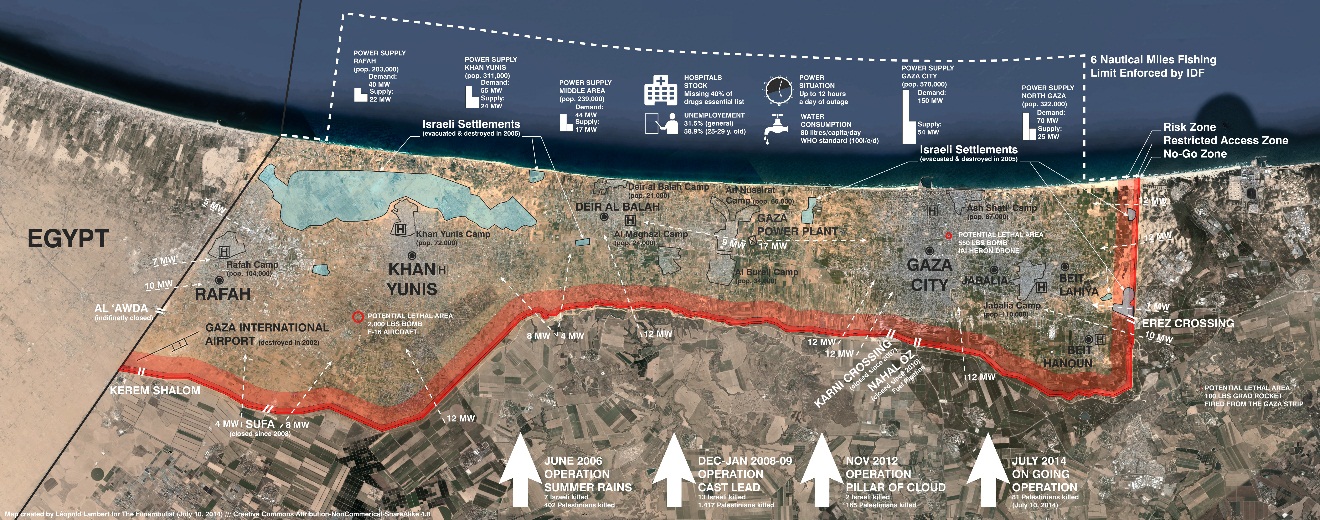 | Figure 1. Infrastructural and Militarized Cartography of Gaza, map created by Léopold Lambert for The Funambulist, July 2014 |
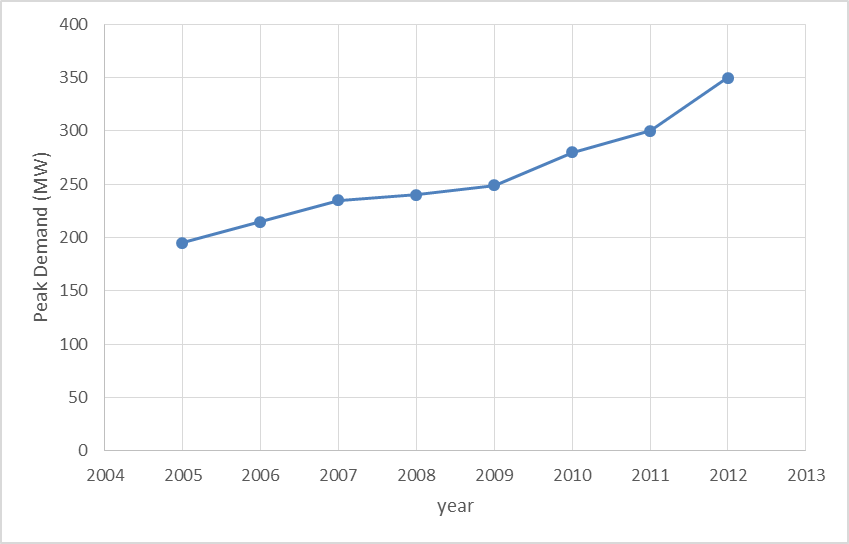 | Figure 2. Electricity Peak Demand for Gaza Strip 2004-2012 (MW), Data Source: Gaza Electricity Distribution Co. limited |
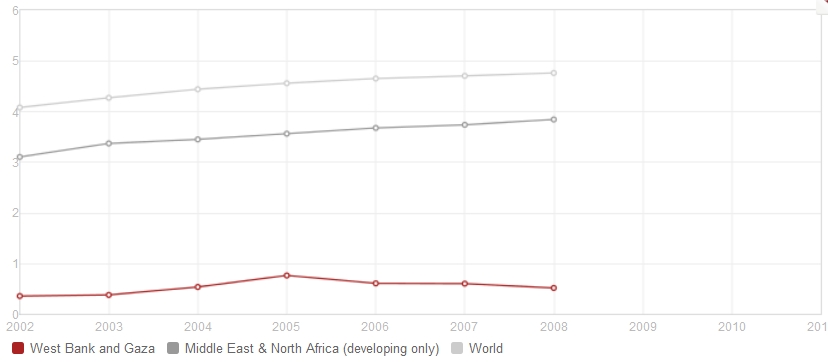 | Figure 3. CO2 Emissions in West Bank and Gaza Strip (metric tons per capita), data source: World Development Indicators |
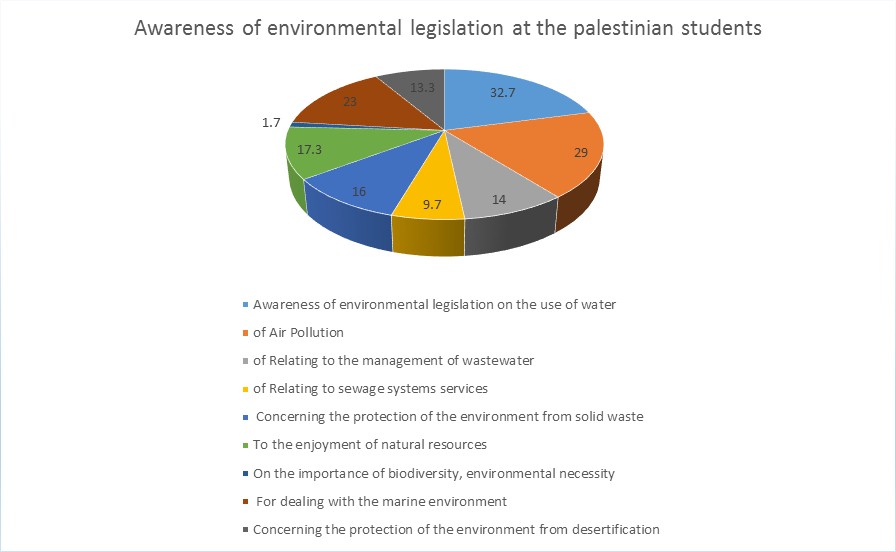 | Figure 4. Awareness of environmental legislation at the Palestinian students 2011; Source of data [6] |
2. Strategy Plan Justifications
- Environmental education and training plays an important role worldwide in enabling the integration of the principles of sustainable development into international, national and local policies and programs for the environment and for education. They also influence how the three pillars of sustainable development- biophysical, economic and social are understood and implemented. This requires a reorientation of educational systems, policies and practices to provide citizens with appropriate knowledge, skills and ethical commitment to engage critically in decision-making and action on current, emerging environmental, and development problems. There are several provisions for education in the Stockholm Plan of Action for the Human Environment, Stockholm 1972. However, it was at the subsequent Rio Conference that the centrality of the role of education for achievement of sustainable development was particularly highlighted [7-10]. The main problem to carry out this strategy is the inability of community in Gaza Strip inclusive the educational system to support and to motivate the benefits of sustainability, usage of renewable energy, and environment protection for human and for its life. The environmental awareness in the Gaza Strip is significantly few and the children of Gaza have many practices that harm their environment. A critical condition for lost public awareness regarding environment is the slow sustainable environmental development (the restoration and rebuilding of environmental governance institutions is almost paralyzed) in Gaza Strip. The Palestinian environmental authorities lost staff, equipment and data because of the recent hostilities and no systematic environmental monitoring systems are currently in place [11], [12]. This strategy plan aims to promote environmental awareness among children and teach them how to protect their environment. Regarding to this issue, this strategy aims to build capacities related to environmental awareness of the community through children. A sample of 20 schools will be selected in cooperation with the Ministry of Education, many activities will be implemented including media activities such as creating publications, creating cartoon films, sending short mobile messages, having TV shows, broadcasting tips on radio and including tips with the monthly electricity and telephone bills. Therefore, special containers for damaged batteries, which will be put in each school to encourage children to bring any damaged batteries and to throw it into this container. Children will then perceive, how damaged batteries are hazardous to their environment and how they could be recycled. In order to give the children the opportunity to express themselves, Environment Friend Groups will be established in each school with the objective of serving and protecting the environment and community by cooperation between the children themselves and working by their hands. Also in each school, there will be an environmental week, which will contains different activities such as, lectures, workshops of art, scientific workshops, competitions and awards, documentary films, cleaning activities, tree planting and a trip to natural places. In those weeks, children will learn a lot of environmental issues. All these activities of learning and teaching, children will be combined with fun, which is important for the personal development of children, and the lessons in good humor could be more effective and can leaves behind a positive remembrance.Therefore, the direct target group is the schoolchildren, because they are the most receptive and have a great capacity for learning, so children from 20 primary schools are going to be selected in cooperation with the Ministry of Education from both genders; males and females equally, over Gaza cities from all governances. The indirect target group will be the families of the children and the local community.
3. Action Plan
- An action plan is a tool in social planning. It is an organizational strategy to identify necessary steps towards a goal. It considers details, may help limit setting for an organization, and is efficient in that it is saving resources over trial and error. A written action plan also serves as a token for an organization's accountability [13].The table 3.1 below describes the activities, which will be implemented within this strategy. A 7-step sustainability action plan for this strategy is used to monitoring the process, and so arranged for easier assessment for later.
|
4. Monitoring, Evaluation and Outcomes
- Within the framework of this strategy, various mechanisms will be putted in place for assessing performance throughout the strategy period. Periodical meetings to follow up and assess the strategy’ activities, periodical progress and training workshops’ reports, quality control standards at the stage of designing and printing publications are to be carried out. At the end of this execution of the strategy, a workshop will be organized for monitoring and evaluating and will be delivered the strategy summary evaluation to develop a strategy for further publications and wider activities for environmental awareness dissemination and teaching. The Outcomes are listed in the Table 4.1.
|
5. Conclusions
- Gaza is an energy-poor country, still needs a lot of care of the people concerning the environment to be done. Environmental awareness for the people in Gaza strip should be an integral part of the education. An institution or a research center for the energy or renewable energy researches is not there. The primary purpose of this center is to promote, coordinate, facilitate and implement research and development projects in renewable and non-renewable energy sources, conservation and sustainability practices, and to bridge the gap between the state-of-the-art and the state-of-practice in energy utilization in Palestine, of course, especially in Gaza Strip. Faculty, visiting scholars and postdoctoral fellows, graduate and undergraduate students should be participate in the research projects and activities of this Center. The research opportunities should be provided by this center, and so will promote innovation, creativity, and intellectual growth in the area of energy research in Gaza-Strip and West bank. Moreover, this center will provide a path for engagement with local and international firms and foundations involved with energy research and management.
 Abstract
Abstract Reference
Reference Full-Text PDF
Full-Text PDF Full-text HTML
Full-text HTML